Content
Anaphalis (Anaphalis) is a genus of herbaceous perennial plants from the Astrov family, including several species and many varieties. Such flowers are often used for landscaping and decorating personal plots. Different varieties of anaphalis are resistant to cold and drought. This explains the popularity of the plant among gardeners.
Description of anaphalis
It is an upright fast-growing shrub. Unlike many other flowering perennials, anaphalis has a strong and deep root system. This allows the shrub to get more nutrients and moisture from the soil, which in turn provides drought tolerance.
The average plant height is 30-40 cm. Some varieties reach a height of 80-100 cm. Plants need a garter or auxiliary support. Anafalis has thin, single stems that can break under the weight of the peduncles.
Erect shoots are covered with fine white hairs. This makes the plant appear silvery or white. On the stems there are a large number of elongated feather-like leaves, resembling stripes. Sometimes they grow in bundles of 3-5 pieces.
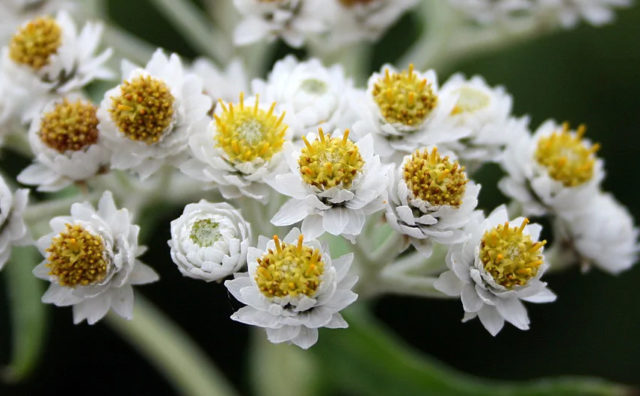
The plant is very weed resistant
Almost all plant varieties are characterized by long flowering. It starts in July or August and lasts 2-2.5 months.
During this period, large corymbose inflorescences, formed from numerous flowers in the form of baskets, appear on the plant. The color depends on the variety and variety. Most anaphalis have flowers with white petals.
Properly planted shrubs can withstand temperatures down to -34 degrees. Therefore, they are suitable for growing in almost any climatic zone of the Russian Federation.
Description of the plant:
Types and varieties of anafalis
The plant has been cultivated for over two hundred years. There are several main types, each of which includes many varieties. Below are the most common in Russia.
Anafalis three-veined
Herbaceous perennial, naturally growing in the Himalayas. Anaphalis three-veined (Anaphalis triplinervis) up to 50 cm high. Erect shrub, with a large number of elongated leaves.
The plant is covered with silvery bristles. This makes it appear gray.
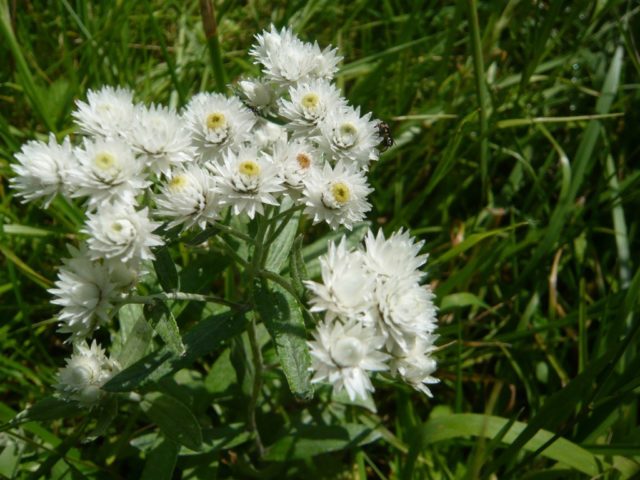
Three-veined anaphalis bloom begins at the end of June and lasts until mid-September
Main varieties:
- Summer snow (Sommerschnee).
- Silver Wave.
- Silver rain (Silberregen).
- Prunes (Snoeien).
- Winter (Winter).
In the photo of trezhilkovy anaphalis, it is noticeable that the rounded flowers are collected in abundant inflorescences. This variety has a high growth rate. During the season, three-leafed anaphalis is recommended to be cut twice.
Anafalis pearl
It is considered the most common type.Anaphalis pearl (Anaphalis margaritacea) - undersized shrub up to 40 cm in height. The plant has fragile stems that dry out in the summer season. Shoots and leaves are gray with a light blue tint.
It blooms for an average of 2 months. On the stems, thyroid-shaped baskets are formed. They consist of numerous flowers up to 1 cm in diameter.

Sections located in partial shade are recommended for planting.
Main varieties:
- Fresh snow (Neuschnee).
- Pearly Everlasting.
The presented variety of anaphalis can be grown on any type of soil. The only important requirement is the presence of a drain to drain excess fluid.
Anafalis Nepalese
A dwarf variety that usually does not grow taller than 30 cm. Nepalese anaphalis (Anaphalis nepalensis) is often used as a ground cover plant. Shoots on bushes grow to the sides. In this case, the stems are located close to each other, due to which the foliage appears thicker.
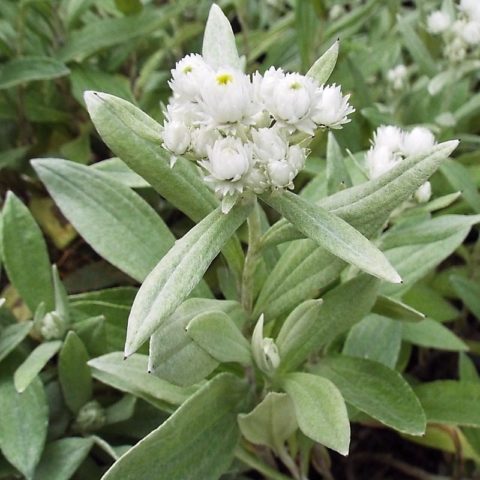
Nepalese anaphalis have 2 types of leaves - root and stem
This variety is considered late. Flowering begins in late summer and lasts until mid-autumn. A distinctive feature of this species is monochromatic buds.
Nepalese perennial anaphalis in nature are found in the mountains at an altitude of 5000 m. This explains the resistance of this plant to cold, winds and abundant sunlight.
Anaphalis velvety
It is a dwarf shrub up to 35 cm high. The velvety anaphalis (Anaphalis velutina) has larger flowers in comparison with other species. Their diameter reaches 2 cm.
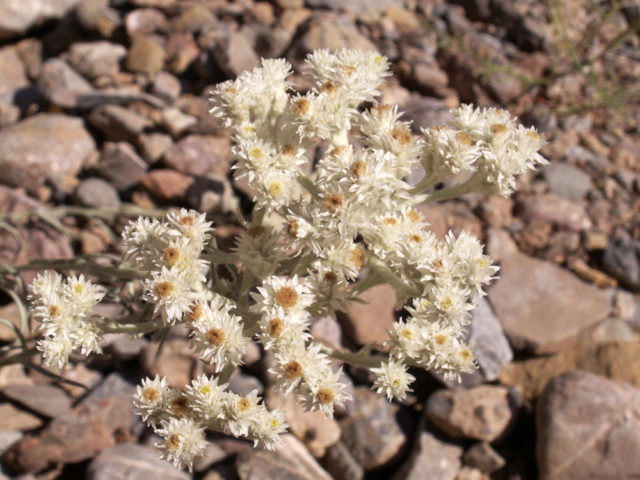
Velvety anaphalis grow well on rocky soils
Erect shrub with many stems and leaves. Shoots slopes towards woodiness that occurs in summer. The decorativeness of the plant remains until the end of September.
Anafalis alpine
Ground cover undersized shrub. Also called Anaphalis alpicola.
During the flowering period, flower stalks up to 40 cm high appear on the bushes. On each, a basket is formed, consisting of small white or gray flowers.
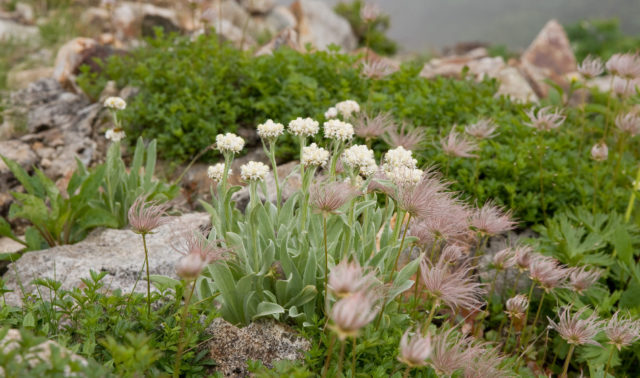
The plant has a unique root leaf shape
Shrub silvery gray. Due to the thick pile, liquid is retained on the shoots and leaves, and they acquire a bright sheen.
Alpine anaphalis grow slowly. However, they tolerate cold, lack of moisture and strong winds well. They can be planted in poor soils.
Anafalis in landscape design
There are a lot of options for using such a shrub for decorative purposes. Usually anaphalis are planted in groups for landscaping, zoning and decorating green borders. The plant is well suited for planting in rockeries and alpine slides.
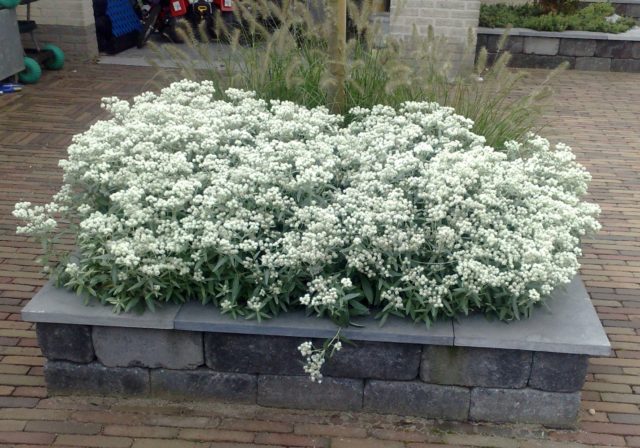
Anafalis is considered compact, therefore it is suitable for any area
In mixborders, anaphalis is planted mainly with annual plants. Low-growth colors of red or blue are best suited, which contrast well against the background of white-gray foliage. Anaphalis perfectly complement compositions using conifers and dwarf deciduous shrubs.
It grows well on rocky soils. Therefore, it is often planted near artificial reservoirs and decorative garden buildings.
Breeding features
The plant tolerates bush division well. The procedure is carried out in spring or autumn after flowering. The entire bush is removed from the soil, several shoots with roots are separated from the plant, which are planted in a new place. For reproduction, bushes are used, the age of which has reached 3 years.
"Delenki" are sometimes planted in pots or flowerpots.Plants adapt, leave for the winter in a cool room and periodically ventilate. Planting in open ground is carried out in the spring.
How to grow anaphalis from seeds
Perennial shrubs are rarely planted by seedlings. This requires quality, healthy seeds. In order for them to germinate, certain conditions must be maintained.
When to plant
To find out the sowing time, you must first determine the expected date of planting in open ground. Seedlings begin to grow in 1.5-2 months. This is enough to germinate the material and get healthy and strong seedlings.

Seeds can be harvested on their own only after the plant has faded.
When growing anaphalis from seeds, it is better to plant at the end of winter. This will allow the plant to harden, making it more resistant to adverse factors. Sowing can be carried out in mid - late February or early March, in order to plant seedlings in open ground in April.
Preparation of containers and soil
For sowing seeds, use seedling cassettes, peat tablets or small glasses. The use of plastic containers with drainage holes, pots and cut bottles is allowed.
For the plant, a nutritious loose soil of peat and river sand is recommended. It must be sufficiently moist and free from coarse particulate matter.
Seeding Algorithm
The method of planting seeds is simple. It is enough to follow the short instructions.
Planting stages:
- Fill the container with potting soil.
- Soak plant seeds in a growth promoter for 10 hours.
- Spray the soil with a spray bottle.
- Spread the seeds over the soil surface at a distance of 2-3 cm from each other.
- Cover the container with foil and leave it indoors at a temperature of 16 degrees.
If soil is taken from an open area, it should be sterilized. This eliminates the risk of infection or pest larvae that can cause irreparable damage to young plants. The soil is placed in the oven for 4-6 hours at a temperature of 80 degrees.
After sowing, the seeds do not need to be covered with earth. After germination, the root system itself deepens into the soil.
Growing anaphalis seedlings
No specific care for the seedlings is required. The container with seedlings should be kept on a windowsill or other place well-lit by the sun. The film is removed 7-8 days after seed germination. Before that, they need to be aired daily.
Seedlings are watered as the soil dries up. Plant picking after seed germination is not required. When they get stronger, they are immediately transplanted into open ground. No stratification is required either.
Planting and caring for anaphalis in the open field
This perennial is known for its unpretentiousness. It can be successfully grown in all conditions. Therefore, planting and caring for an anaphalis flower comes down to a set of simple activities.
Recommended timing
When grown by seedlings, spring planting is the best option. Then it is easier for the plant to adapt to new conditions. The bush manages to take root and endure the winter in the future.
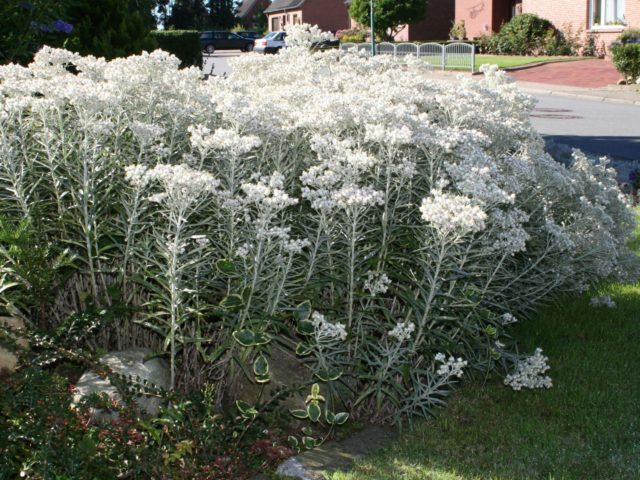
Anafalis can bloom even in the first year after moving to open ground.
Autumn planting of the plant is preferable when planting large seedlings or "delenok". They must be placed in open ground after flowering. In this case, the buds must be removed to stimulate root growth.
Site selection and soil preparation
For anaphalis, areas located in partial shade are best suited. However, the plant grows well in sunlit places. It is desirable that there is no stagnation of air on the site. The presence of drafts in this case is a plus.
Most varieties of anaphalis are not demanding on the composition of the soil. It shouldn't be too dry. Acidity is neutral.
Perennial anaphalis does not require a lot of nutrients. Planting in sandy and loamy soils is allowed, provided that they are sufficiently loose.
Landing
Anaphalis should be planted in the soil in accordance with the general technology. Then the flower fully adapts to open ground.
Main steps:
- Prepare a planting hole 25-30 cm deep.
- Place drainage layers of expanded clay, crushed stone or pebbles.
- Sprinkle with fresh loose soil.
- Place the seedling in the hole, pointing the roots to the sides.
- Cover with soil so that the upper roots are at a depth of 4-5 cm.
- Spill surface soil with water.
If it is necessary to limit the growth of roots, a sheet of slate should be placed on the bottom of the pit and along the walls. Also for these purposes brick, stone and wood are used.
Watering and feeding schedule
For anaphalis, moisture deficiency is not harmful. The shrub tolerates drought well. Regular watering is required during the flowering period, as well as to prevent premature drying out of the stems. 5-10 liters of liquid are added under each bush, depending on the size.
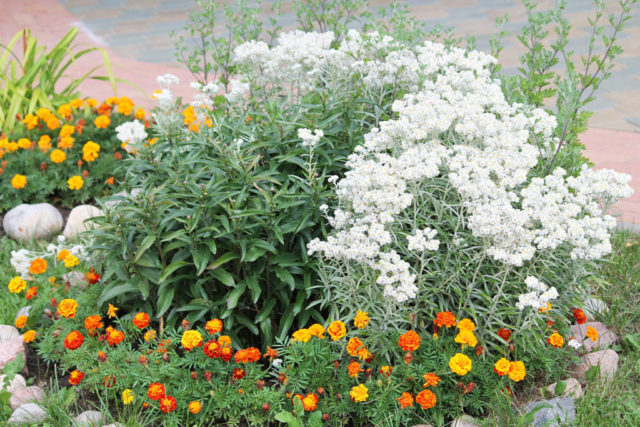
For regular abundant growth, the plant does not require feeding
The introduction of fertilizers into the soil affects the growth rate of the roots of anaphalis, and does not affect the size of the bush itself. Therefore, there is no need for organic and mineral fertilizing. The exceptions are cases when anaphalis are planted next to other plants that are more demanding on the composition of the soil.
Loosening and mulching
Anaphalis roots need space. In order for them to grow normally underground, it is required to periodically loosen the soil. The procedure is carried out as it compresses, which is especially important after heavy precipitation or regular watering of the plant. In summer, soil loosening is carried out 2 times a month.
Soil mulching is carried out during the dry season. The material that retains moisture is introduced into the soil by 6-8 cm. Wood bark, straw, peat or compost are used as mulch.
Pruning
Shearing is required for both large and stunted plants. The first is recommended to be carried out 2-3 weeks before flowering. Shoots are cut from the bushes, on which there are no buds. In the future, this stimulates the growth of flower stalks and promotes more abundant flowering of the plant.
The second pruning is designed to prepare the bushes for wintering. First, wilted baskets with flowers are cut from anaphalis, then stem shoots to the ground. 3-4 cm of them are left from the surface, which can be covered for the winter with spruce branches or dry foliage to protect them from freezing.
Diseases and pests
Anafalis does not need protection from infections or insects. The plant is not affected by bacteria and fungi. Diseases are extremely rare, usually due to excessive watering. Excess liquid contributes to decay of plant roots, which leads to wilting of the bush. To prevent such a pathology, it is enough to observe the watering regime and add a drainage layer when planting.
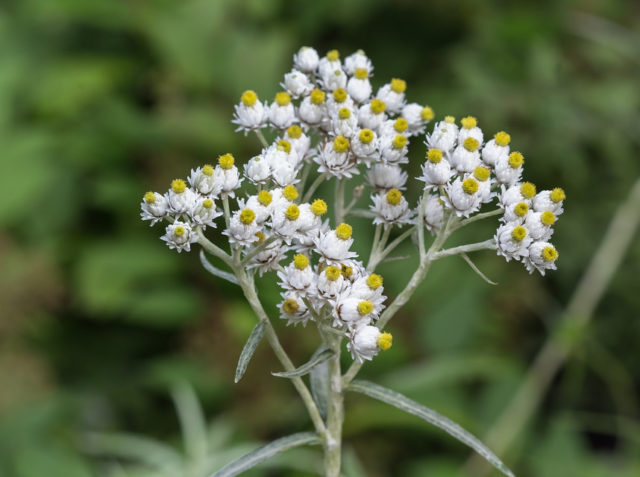
Anafalis is resistant to diseases and pests if the soil is not waterlogged
Almost all varieties of anaphalis exude a specific smell that is almost imperceptible to the human sense of smell. This scent is harmless, but it repels insects. Therefore, the perennial is not affected by pests that can cause significant damage.
The healing properties of anaphalis
This plant was previously used for medicinal rather than ornamental purposes. The most beneficial is pearl anaphalis, which is used in the manufacture of medicines in combination with other herbal ingredients.
The aerial part of the plant - leaves and flowers - has healing properties. A concentrated extract is obtained from them by distillation or steam stripping.
It has the following properties:
- expectorant;
- hemostatic;
- vasotonic;
- antiseptic;
- astringent.
Such properties are explained by the content of rosafuran anaphalis extract.Preparations with this substance are used for numerous diseases.
Plant application
Due to its unique properties, anaphalis varieties are used for various purposes. The most common area of application, in addition to decorative, is medicine. Anaphalis is also used in cosmetology and floristry.
In folk medicine
Dried flowers and shrub leaves are actively used for medicinal purposes. The material can be prepared with your own hands, collecting it from the plant, or purchased at the pharmacy. When self-harvesting, the collection is carried out during flowering.
The most common drug option is anaphalis infusion. To prepare 2 tablespoons of dried flowers and leaves, pour 300 ml of boiling water. The mixture is insisted for 2-3 hours.
The resulting liquid is used for:
- washing wounds, burns, cuts;
- muscle recovery after stretching;
- acne treatment, acne;
- pain relief and removal of edema against the background of injuries, damage to tendons, ligaments;
- for lotions for fungal forms of lichen;
- for compresses for headaches, arthritis, rheumatism.
The infusion can also be used internally. At the same time, it is diluted with water 1 to 1. Oral administration is indicated for numerous diseases.
Among them:
- diarrhea;
- bronchopulmonary diseases accompanied by cough;
- insomnia;
- nervous strain, stress, as a sedative;
- headaches;
- muscle neuralgia.
As a folk remedy, essential oil is obtained from anaphalis. It is used for steam inhalation for respiratory diseases.
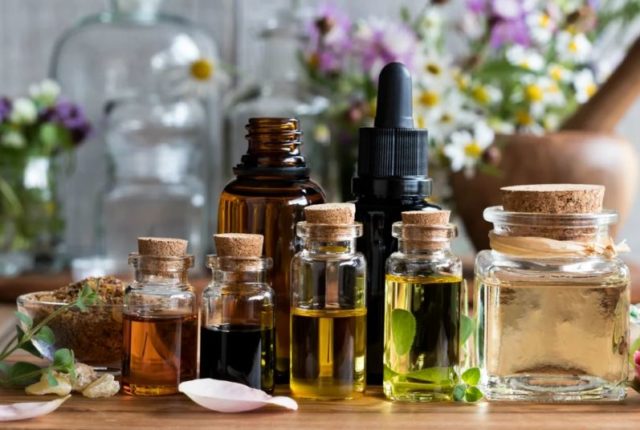
Anaphalis oil is often used for massage procedures.
It is necessary to take into account possible contraindications and restrictions of folk remedies. Before using anaphalis for medicinal purposes, you need to consult a doctor.
In cosmetology
The effectiveness of the use of pearl anaphalis for various skin diseases has been scientifically confirmed. Therefore, the plant extract is often added to cosmetics.
At home, you can prepare a concentrated infusion. It is used to wipe problem areas of the skin. It is advisable to prepare an anaphalis infusion for pathologies caused by a bacterial or fungal infection. For prophylactic purposes, it is used as a means for washing.
In floristry
Numerous photos and descriptions of the anaphalis flower indicate that such a plant is actively used to create bouquets that decorate rooms. Moreover, the decorative function is performed by both fresh and dried specimens.
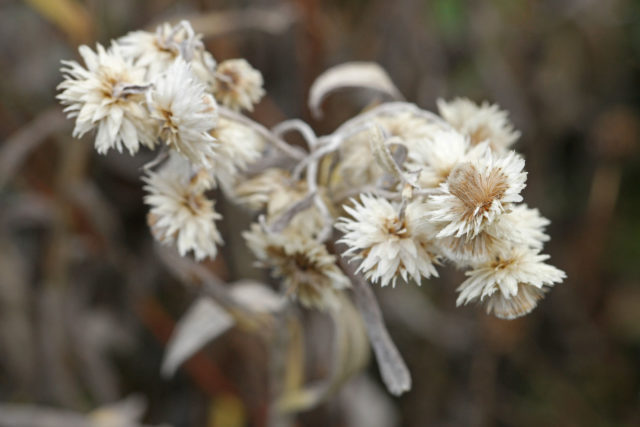
Dried Anaphalis - Popular Dried Flower Plant
Flowers are used for compositions in combination with other plants. Also, anaphalis can be cut off and placed without addition. They retain their decorative effect for a long time and look good even after drying. Therefore, bouquets of them will well complement any interior.
Conclusion
Anafalis is a perennial plant with winter hardiness, low sensitivity to drought and excellent decorative qualities. There are many varieties that differ in the size of the bush. In landscape design, both tall and dwarf types of anaphalis are used. The flower is unpretentious and grows well in any conditions.








